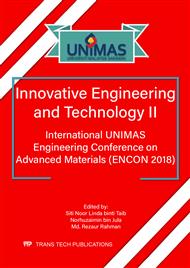[1]
Information on https://www.teck.com/media/BofAML-Global-Conference-Final.pdf.
Google Scholar
[2]
D.G. Rogich and G.R. Matos, The global flows of metals and minerals. U.S. Geological Survey Open-File Report 2008–1355, 11 p., (2008).
DOI: 10.3133/ofr20081355
Google Scholar
[3]
K.T. Pui, The Mineral Industry of Malaysia. U.S. Geological Survey Minerals Yearbook-2013, 17.1-17.7, (2015).
Google Scholar
[4]
Department of Environment Malaysia (DOE), Malaysia Environmental Quality Report 2011, 2011, http://www.doe.gov.my/webportal/en/penerbitan-jas.
Google Scholar
[5]
A. B. Noorhazlina, Speciation of heavy metals in sludge from electroplating industry, Masters Thesis, University of Malaya, 1-89, (2013).
Google Scholar
[6]
World Health Organization, Training Package for the Health Sector: Adverse Health Effects of Heavy Metals in Children, World Health Organization, 2011, Retrieved from http://www.who.int/ceh/capacity/heavy_metals.pdf.
Google Scholar
[7]
S. S. Ahluwalia and D. Goyal, Removal of Heavy Metals by Waste Tea Leaves from Aqueous Solution, Engineering in Life Sciences, 5(2), 158-162, (2005).
DOI: 10.1002/elsc.200420066
Google Scholar
[8]
M. S. Rajput, A. K. Sharma, S. Sharma, S. Verma, Removal of Lead from aqueous solution using low cost abundantly available adsorbent, International Journal of Chemical Studies, 3(1), 09-14, (2015).
Google Scholar
[9]
W. T. Tan, Copper Adsorption by Waste Tea Leaves and Coffee Powder. Pertanika, 8(2), 223-230, (1985).
Google Scholar
[10]
Information on https://worldteanews.com/tea-industry-news-and-features/discovering-tea-malaysia.
Google Scholar
[11]
K. L. Wasewar, M. Atif, B. Prasad, and I. M. Mishra, Batch Adsorption of Zinc on Tea Factory Waste, Desalination, 244, 66 – 71, (2009).
DOI: 10.1016/j.desal.2008.04.036
Google Scholar
[12]
B.K. Saritha, M. Sathish, R. V. Arunrajkumar, Experimental Study of Tea Waste as Adsorbent in Removal of Chromium (VI) from Aqueous Solution. International Journal of Engineering Trends and Technology, 2(2), 8-10, (2011).
Google Scholar
[13]
T. Ainane, K. Fatima, M. Talbi, & M. Elkouali. A Novel Bio-Adsorbent of Mint Waste for Dyes Remediation in Aqueous Environments: Study and Modeling of Isotherms for Removal of Methylene Blue, Oriental Journal of Chemistry, 30(3), 1183-1189, (2014).
DOI: 10.13005/ojc/300332
Google Scholar
[14]
M. Cheraghi, S. Sobhanardakani, R. Zandipak, B. Lorestani and H. Merrikhpour, Removal of Pb (II) from Aqueous Solutions Using Waste Tea Leaves, Iranian Journal of Toxicology, 9(28), (2015).
Google Scholar
[15]
S.S. Shukla, L.J. Yu, K.L. Dorris, A. Shukla, J.L. Margrave, Adsorption of chromium from aqueous solutions by maple sawdust, Journal of Hazardous Materials .100 (1–3):53–63, (2003).
DOI: 10.1016/s0304-3894(03)00008-6
Google Scholar
[16]
N. Dizadji and N. Abootalebi Anaraki, Adsorption of chromium and copper in aqueous solutions using tea residue, International Journal of Environmental Science & Technology, 8(3), 631-638, (2011).
DOI: 10.1007/bf03326248
Google Scholar
[17]
N. Barka, S. Qouzal, A. Assabbane, A. Nounhan, Y.A. Ichou, Removal of reactive yellow 84 from aqueous solutions by adsorption onto hydroxyapatite, J. Saudi Chem. Soc. 15, 263–267, (2011).
DOI: 10.1016/j.jscs.2010.10.002
Google Scholar
[18]
L. S. Thakur and M. Parmar, Adsorption of Heavy Metal (Cu2+, Ni2+ and Zn2+) from Synthetic Waste Water by Tea Waste Adsorbent, International Journal of Chemical and Physical Sciences, 2(6), 6-19, (2013).
Google Scholar
[19]
J. Iqbal, F.H. Watto, M.H.S Watto, R. Malik, S.A. Tirmizi, M. Imran, A.B. Ghangro, Adsorption of acid yellow dye on flakes of chitosan prepared from fishery waste, Arabian J. Chem. 4, 389–395, (2011).
DOI: 10.1016/j.arabjc.2010.07.007
Google Scholar


